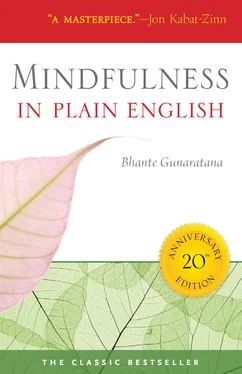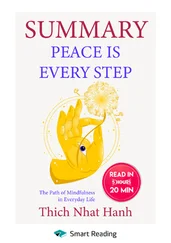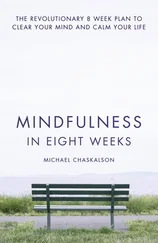Henepola Gunaratana - Mindfulness in Plain English
Здесь есть возможность читать онлайн «Henepola Gunaratana - Mindfulness in Plain English» весь текст электронной книги совершенно бесплатно (целиком полную версию без сокращений). В некоторых случаях можно слушать аудио, скачать через торрент в формате fb2 и присутствует краткое содержание. Жанр: Самосовершенствование, на английском языке. Описание произведения, (предисловие) а так же отзывы посетителей доступны на портале библиотеки ЛибКат.
- Название:Mindfulness in Plain English
- Автор:
- Жанр:
- Год:неизвестен
- ISBN:нет данных
- Рейтинг книги:3 / 5. Голосов: 1
-
Избранное:Добавить в избранное
- Отзывы:
-
Ваша оценка:
- 60
- 1
- 2
- 3
- 4
- 5
Mindfulness in Plain English: краткое содержание, описание и аннотация
Предлагаем к чтению аннотацию, описание, краткое содержание или предисловие (зависит от того, что написал сам автор книги «Mindfulness in Plain English»). Если вы не нашли необходимую информацию о книге — напишите в комментариях, мы постараемся отыскать её.
Mindfulness in Plain English — читать онлайн бесплатно полную книгу (весь текст) целиком
Ниже представлен текст книги, разбитый по страницам. Система сохранения места последней прочитанной страницы, позволяет с удобством читать онлайн бесплатно книгу «Mindfulness in Plain English», без необходимости каждый раз заново искать на чём Вы остановились. Поставьте закладку, и сможете в любой момент перейти на страницу, на которой закончили чтение.
Интервал:
Закладка:
The Vipassana meditator uses his concentration as a tool by which his awareness can chip away at the wall of illusion which cuts him off from the living light of reality. It is a gradual process of ever-increasing awareness and into the inner workings of reality itself. It takes years, but one day the meditator chisels through that wall and tumbles into the presence of light. The transformation is complete. It’s called liberation, and it’s permanent. Liberation is the goal of all buddhist systems of practice. But the routes to attainment of the end are quite diverse.
There are an enormous number of distinct sects within Buddhism. But they divide into two broad streams of thought—Mahayana and Theravada. Mahayana Buddhism prevails throughout East Asia, shaping the cultures of China, Korea, Japan, Nepal, Tibet and Vietnam. The most widely known of the Mahayana systems is Zen, practiced mainly in Japan, Korea, Vietnam and the United States. The Theravada system of practice prevails in South and Southeast Asia in the countries of Sri Lanka, Thailand, Burma, Laos and Cambodia. This book deals with Theravada practice.
The traditional Theravada literature describes the techniques of both Samatha (concentration and tranquility of mind) and Vipassana (insight or clear awareness). There are forty different subjects of meditation described in the Pali literature. They are recommended as objects of concentration and as subjects of investigation leading to insight. But this is a basic manual, and we limit our discussion to the most fundamental of those recommended objects—breathing. This book is an introduction to the attainment of mindfulness through bare attention to, and clear comprehension of, the whole process of breathing. Using the breath as his primary focus of attention, the meditator applies participatory observation to the intirety of his own perceptual universe. He learns to watch changes occurring in all physical experiences, in feelings and in perceptions. He learns to study his own mental activities and the fluctuations in the character of consciousness itself. All of these changes are occurring perpetually and are present in every moment of our experiences.
Meditation is a living activity, an inherently experiential activity. It cannot be taught as a purely scholastic subject. The living heart of the process must come from the teacher’s own personal experience. Nevertheless, there is a vast fund of codified material on the subject which is the product of some of the most intelligent and deeply illumined human beings ever to walk the earth. This literature is worthy of attention. Most of the points given in this book are drawn from the Tipitaka, which is the three-section collected work in which the Buddah’s original teachings have been preserved. The Tipitaka is comprised of the Vinaya, the code of discipline for monks, nuns, and lay people; the Suttas, public discourses attributed to the Buddha; and the Abhidhamma, a set of deep psycho-philosophical teachings.
In the first century after Christ, an eminent Buddhist scholar named Upatissa wrote the Vimuttimagga , (The Path of Freedom) in which he summarized the Buddha’s teachings on meditation. In the fifth century A.C. (after Christ,) another great Buddhist scholar named Buddhaghosa covered the same ground in a second scholastic thesis—the Visuddhimagga , (The Path of Purification) which is the standard text on meditation even today. Modern meditation teachers rely on the Tipitaka and upon their own personal experiences. It is our intention to present you with the clearest and most concise directions for Vipassana meditation available in the English language. But this book offers you a foot in the door. It’s up to you to take the first few steps on the road to the discovery of who you are and what it all means. It is a journey worth taking. We wish you success.
Chapter 1
Meditation: Why Bother?
Meditation is not easy. It takes time and it takes energy. It also takes grit, determination and discipline. It requires a host of personal qualities which we normally regard as unpleasant and which we like to avoid whenever possible. We can sum it all up in the American word ‘gumption’. Meditation takes ‘gumption’. It is certainly a great deal easier just to kick back and watch television. So why bother? Why waste all that time and energy when you could be out enjoying yourself? Why bother? Simple. Because you are human. And just because of the simple fact that you are human, you find yourself heir to an inherent unsatisfactoriness in life which simply will not go away. You can suppress it from your awareness for a time. You can distract yourself for hours on end, but it always comes back—usually when you least expect it. All of a sudden, seemingly out of the blue, you sit up, take stock, and realize your actual situation in life.
There you are, and you suddenly realize that you are spending your whole life just barely getting by. You keep up a good front. You manage to make ends meed somehow and look OK from the outside. But those periods of desperation, those times when you feel everything caving in on you, you keep those to yourself. You are a mess. And you know it. But you hide it beautifully. Meanwhile, way down under all that you just know there has got be some other way to live, some better way to look at the world, some way to touch life more fully. You click into it by chance now and then. You get a good job. You fall in love. You win the game, and for a while, things are different. Life takes on a richness and clarity that makes all the bad times and humdrum fade away. The whole texture of your experience changes and you say to yourself, “OK, now I’ve made it; now I will be happy.” But then that fades, too, like smoke in the wind. You are left with just a memory. That and a vague awareness that something is wrong.
But there is really another whole realm of depth and sensitivity available in life, somehow, you are just not seeing it. You wind up feeling cut off. You feel insulated from the sweetness of experience by some sort of sensory cotton. You are not really touching life. You are not making it again. And then even that vague awareness fades away, and you are back to the same old reality. The world looks like the usual foul place, which is boring at best. It is an emotional roller coaster, and you spend a lot of your time down at the bottom of the ramp, yearning for the heights.
So what is wrong with you? Are you a freak? No. You are just human. And you suffer from the same malady that infects every human being. It is a monster in side all of us, and it has many arms: Chronic tension, lack of genuine compassion for others, including the people closest to you, feelings being blocked up, and emotional deadness. Many, many arms. None of us is entirely free from it. We may deny it. We try to suppress it. We build a whole culture around hiding from it, pretending it is not there, and distracting ourselves from it with goals and projects and status. But it never goes away. It is a constant undercurrent in every thought and every perception; a little wordless voice at the back of the head saying, “Not good enough yet. Got to have more. Got to make it better. Got to be better.” It is a monster, a monster that manifests everywhere in subtle forms.
Go to a party. Listen to the laughter, that brittle-tongued voice that says fun on the surface and fear underneath. Feel the tension, feel the pressure. Nobody really relaxes. They are faking it. Go to a ball game. Watch the fan in the stand. Watch the irrational fit of anger. Watch the uncontrolled frustration bubbling forth from people that masquerades under the guise of enthusiasm, or team spirit. Booing, cat-calls and unbridled egotism in the name of team loyalty. Drunkenness, fights in the stands. These are the people trying desperately to release tension from within. These are not people who are at peace with themselves. Watch the news on TV. Listen to the lyrics in popular songs. You find the same theme repeated over and over in variations. Jealousy, suffering, discontent and stress.
Читать дальшеИнтервал:
Закладка:
Похожие книги на «Mindfulness in Plain English»
Представляем Вашему вниманию похожие книги на «Mindfulness in Plain English» списком для выбора. Мы отобрали схожую по названию и смыслу литературу в надежде предоставить читателям больше вариантов отыскать новые, интересные, ещё непрочитанные произведения.
Обсуждение, отзывы о книге «Mindfulness in Plain English» и просто собственные мнения читателей. Оставьте ваши комментарии, напишите, что Вы думаете о произведении, его смысле или главных героях. Укажите что конкретно понравилось, а что нет, и почему Вы так считаете.












